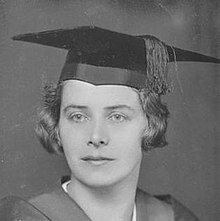| Emily Dix | |
|---|---|
 | |
| Born | 21 May 1904 |
| Died | 31 December 1972 |
| Nationality | British |
| Alma mater | University of Wales |
| Scientific career | |
| Fields | Paleobotany |
| Institutions | |
| Thesis | On the correlation of coal seams in South Wales (1933) |
| Academic advisors | Arthur Trueman |
Emily Dix (21 May 1904 – 31 December 1972) was a British palaeobotanist, specialising in the fossil flora of the Coal Measures.
Education
She was born into a farming family living at Llanrhidian on the Gower Peninsula. At 18 she won a scholarship to University College Swansea where she graduated in 1925 with a first class honours degree in geology. She then went on to study with Arthur Trueman at Swansea, with whom she worked for the next five years on various projects. T. Neville George worked with her on the Coal Measures. She was awarded an M. Sc. in 1926 for work on paleontology in the Coal Measures of the Gwendraeth Valley in South Wales and a DSc.doctorate from the University of Wales in 1933 for a thesis about correlation of coal seams in South Wales. Her research was supported by grants from the government because of its importance to the coal industry.
Academic career
In 1929 Dix was elected a Fellow of the Geological Society. In 1930 she was appointed lecturer in geology at Bedford College in London, where she stayed for the rest of her working life.
Her initial work, following that of Truman, was on non-marine bivalves in the South Wales Coalfield. This remained an interest throughout her working life. Dix's major contribution was to apply Trueman's approach to biostratigraphy to plant fossils.
She presented her work at international conferences including the Second International Carboniferous Congress in Heerlen (the Netherlands) in 1935. In 1936 she was awarded the Murchison Fund by the Geological Society of London for her work on palaeontology and stratigraphy in the Coal Measures that combined flora and faunal evidence, thus improving information about the Upper Carboniferous successions. This information was useful to the coal industry as well as fundamental science.
World War II came at the height of her career, and disrupted her scientific activities. Along with the rest of Bedford College, she was evacuated to Cambridge, leaving behind her collections of fossils and scientific reprints which were later lost through bombing.
Dix's wartime papers were mainly on relatively minor aspects of coal geology (e.g. the presence of boulders in coal seams) and plant biostratigraphy is rarely mentioned. Bedford College returned to London in 1944 and Dix led a field trip of the Geologists' Association to Guildford in June 1945.
Personal life
Towards the end of the war, Dix suffered a mental breakdown which caused the end of her scientific career.
By 1946, her condition had so deteriorated that her sister Margaret had taken over her affairs, and moved Dix to The Retreat mental hospital in York, where she had new experimental surgery called prefrontal leucotomy which was unsuccessful and ruined her ability to ever recover. Her contract with the Bedford College formally expired on 31 December 1947. She was then transferred to St David's Hospital Carmarthen where she remained until her death.
Legacy
Most of her fossils survived and her collection is now divided between the Hunterian Museum in Glasgow, Amgueddfa Cymru - National Museum of Wales in Cardiff, and the Sedgwick Museum in Cambridge.
Selected publications
She published 40 articles and notes. They included:
- Dix, E. (1934) The sequence of floras in the Upper Carboniferous with special reference to South Wales. Transactions of the Royal Society of Edinburgh. volume 57, pp 789.
- Dix, Emily (1932) On a sporocarp probably attached to a frond of Neuropteris schlehani, Stur. Annals of Botany, Volume 46, Issue 4, 1 October 1932, Pages 1064–1067
- Dix, E. (1931) The flora of the upper part of the Coal Measures of North Staffordshire. Quarterley J. Geological Society, volume 87, 160 - 179.
- Davies, D. F., Dix, E. and Truhman, A. F. (1928) Boreholes in the Cwmgorse Valley. Proc. South Wales Inst. Eng., vol. xliv, pages 37.
- Dix, Emily (1928) Seeds associated with Linopteris munsteri, Eichwald. Annals of Botany, Volume 42, Issue 4, 1 October 1928, Pages 1019–1024
References
- ^ Watts, Shelby. "Emily Dix". TrowelBlazers. Retrieved 15 October 2017.
- ^ Burek, Cynthia (July 2005). "Emily Dix, palaeobotanist – a promising career cut short". Geology Today. 21 (4): 144–145. doi:10.1111/j.1365-2451.2005.00518.x. hdl:10034/12182.
- Burek, Cynthia V.; Cleal, Christopher J. (1 January 2005). "The life and work of Emily Dix (1904 - 1972)". Geological Society, London, Special Publications. 241 (241): 181–196. CiteSeerX 10.1.1.830.1035. doi:10.1144/GSL.SP.2003.207.01.14.
Further reading
- Burek, C. V. & Cleal, C. J. (2005) The life and work of Emily Dix (1904-1972). In: Bowden, A. J., Burek, C. V. & Wilding, R (ed.) History of palaeobotany: selected essays. Geological Society of London, Special Publication, 241, 181–196.